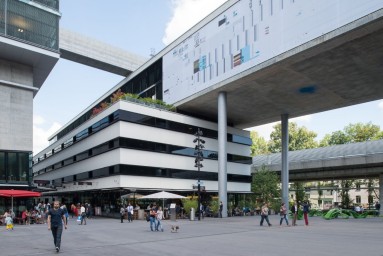Shopping Center
Interview with Philipp Schoch, Head of Center and Mixed-Use Site Management, Wincasa
Simon Keller spoke with Philipp Schoch.

Shopping centres with a size of 5,000 m2 or more are referred to as shopping centres in Switzerland. How would you define a shopping center qualitatively?
According to the classic definition, a shopping center represents "a collection of different retail stores with a wide range of products under one roof". I would supplement this with a "diverse or a specialized offer" in the form of an industry cluster. "Under one roof" should not be understood literally, but as a spatial boundary of the shopping center as a footprint. A good accessibility by public transport and/or the MIV is a mandatory requirement. In addition, larger shopping centers need their own brand, which can be developed and strengthened. Good examples of this are the Sihlcity or the Glattzentrum.
According to the above definition, there are around 190 shopping centers in Switzerland. Can the shopping centers be divided into groups?
There are different approaches to dividing shopping centers into possible groups. A simple approach would be the threefold division: Shopping centers can be divided into the three groups A, B and C due to their location. A-Centers are large shopping centers (from about 35,000 m2) in a good location, but not necessarily in the Central Business District (CBD). They have a diverse retail trade and, depending on the center, a strong range of complementary products, have their own brand and are often well developed. Examples of this in the Zurich region are the Sihlcity or the Shoppi Tivoli. B-Centers are medium-sized centers (10'-20'000 m2) with a food provider as the main tenant and some other shops. The choice within an industry is not huge, as the area does not allow this either. If they focus on their immediate environment, such B-Centers can work. However, there is little demand for retail space at B-Centers today, as they often do not have a clear profile. C-Centers are located in today's poor locations, which used to work, because there was no offer in the area at that time. These centers already have vacancies and will be increasingly reused in the future.
As is well known, brick-and-mortar retail is under pressure. Certain experts assume that a quarter of the space in shopping centers will be freed up or unused. Do you agree with this and which type of shopping center is particularly affected?
Yes, shopping centers are under pressure. It is difficult to estimate how many areas will become available. The reason for this is not primarily the growing online trade, but the oversupply of retail space in Switzerland. The retail spaces created in recent years usually better meet today's needs, i.e. they have a higher "footfall" (customer frequency), are better developed, have a more modern infrastructure and meet contemporary shop space requirements. This increases the pressure on existing shopping centers, which are not yet "end-of-life" in terms of construction and from an investment point of view.
The most affected are the B-Centers (10-20,000 m2) with the strategy of an all-purpose provider. B-Centers are too small and today often in the wrong location for the strategy of an all-purpose provider (A-Center), but too large for a pure neighborhood orientation (<10,000 m2). An example of a B-Center is the A1-Center in Oftringen, which is struggling with this challenge and is now being converted, among other things, by the arrival of the Bauhaus (specialist hardware store).
Smaller centers (<10,000 m2) with a food provider, which is supplemented by two to three service providers such as a pharmacy or a hairdresser, are more oriented towards the district and thus have better future opportunities in a functioning, lively district.
Retail centers of different sizes are also often affected by structural change, as their location is no longer relevant for the retail trade.
A-Centers (> 30'000m2) have fewer problems due to their good locations and accessibility, will also have to adapt by offering more service and less classic retail.
Shopping centers are to develop from shopping temples to experience centers; this is the mantra of retail consultants. To this end, the share of gastronomy, leisure activities and services in the shopping centers is to be increased. Do they agree with these recommendations?
This is the right recommendation to use areas that are no longer used by retailers differently, to preserve the existing infrastructure, such as parking and development, and to convert the location almost into 24-hour operation. However, this strategy only makes sense for the 10 to 20 largest shopping centers (A-Centers) of the approximately 195 centers in Switzerland. These are large enough and sufficiently well developed that they are also attractive for wellness and entertainment uses. We would never build a cinema or a hotel into a pure neighbourhood or specialist retail centre. In these centers, the catering industry also has a hard time, which is strongly dependent on the "footfall" (customer frequency). Often, catering establishments in B-Center are operated and cross-subsidized by large retail chains.
Functioning inner cities also represent worlds of experience with a variety of uses and usually attractive quality of stay. How will they differ from shopping centers in the future?
The classic answer is that a customer has to walk less far in the shopping center than in the city center. In addition, the center management controls the offer for an optimal benefit of the customer. With a few exceptions, such as the West-End Company in London, there is no comparable city management in the inner cities. The City Association in the city of Zurich, of which I was also a member as Center Manager Sihlcity, is a start. But it takes more than joint marketing campaigns. However, it is not easy for the City Association to organize events in which more than a few department stores participate. A small retailer in the city centre often does not have the opportunity to participate to the same extent. Be it financially or with opening hours or "manpower". This is understandable in a way. In shopping centers, marketing is increasingly shifting from tenants to owners who promote their shopping center brand (e.B. Sihlcity). Even in the city center, at least according to marketing theory, it should be the task of the landowners to conduct joint marketing in order to ensure an attractive location in the long term. However, since the highstreets in the inner cities belong to different owners, offer management and active fire strategy are only possible to a limited extent. The requirements in a shopping center are clearly different.

Why is this not done in the shopping centers and in the inner cities?
This is a question of risk for the investor or his risk aversion. A medium-sized shopping center generates, say, about CHF 8 million in rental income, while the ground floor areas of a good inner-city property, for example, generate CHF 1.5 million, plus further rental income, e.B. through office use on the upper floors. In addition, a shopping center is usually less flexible in its conversion than an inner-city property. In an investor's real estate portfolio, a large shopping center therefore usually represents a greater risk, which is why an investor cares more about it than about a single diversified property in the city center. Department stores such as Jelmoli and Globus can be compared to shopping centers under this consideration.
The size of retail space has long increased, which is now being called into question with digitization. What developments do you see in the shopping centers?
It is true that the space requirements of the individual retail chains are decreasing again. The Multi Media division used to look for locations with 3,500 – 4,000 m2; today often rather 1'000 to 1'800 m2. This is not only due to the impact of online trading. An improved supply chain with faster logistics also leads to a reduction in warehouses and sales areas in stationary retail. Areas are optimized, because they represent an important cost in the retail trade after the cost of goods and personnel. The extent to which showrooming will affect the space requirements of stationary retail can only be guessed, as this is only rudimentarily available.
If certain scenarios in the retail trade are to be believed, customers will less often transport the purchased goods home themselves. Does this make accessibility through the MIV less important for shopping centers and for the city center?
In the past, there were clear sales calculations based on the number of parking spaces. This is no longer the case today. Examples such as Sihlcity show that there is another way. With 850 parking spaces alone, the necessary turnover could never be generated. Today, 70% of Sihlcity visitors come by public transport. In the case of Glatt, which once had 4,000 parking spaces, it was just the opposite. With the Glatt Valley Railway, the proportion of public transport has increased.
The parking issue is often used by retailers as an excuse to distract from the real problem, their unattractive offer. Certainly, especially in the luxury segment, there will always be customers who want to drive their limousine directly from the store. However, this is no longer the case for the overall market.
The home delivery service, as offered in various shopping centers, remains a niche product. In Sihlcity, with 20,000 visitors per day, there are around 50 deliveries. Many customers carry their shopping bags home themselves or take public transport. Home delivery services outside the city do not work at all. That is why we have switched to external courier services for individual shopping centers where a delivery service is a requirement, which take over the few deliveries per year.
Will there be more shopping centers or urban entertainment centers in the city of Zurich or its surroundings in the medium term?
If you look purely at the density of the retail trade, there is no need for new shopping centers. However, if such a person had a locational advantage, it could work. One has to ask oneself how centrally located such a center can be, i.e. how expensive the property and how far peripheral a location can be, i.e. how good the development must be. Attractive locations for large shopping centers with over 35,000 m2 are probably no longer available in the Zurich area; out of existing building fabric would be demolished.